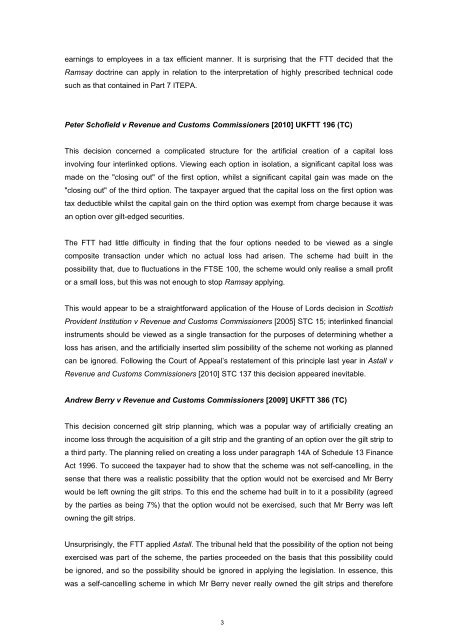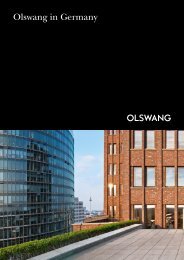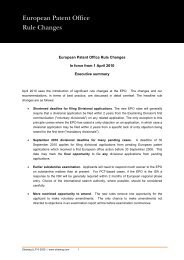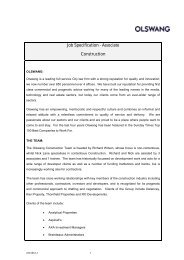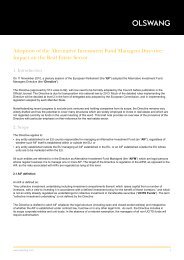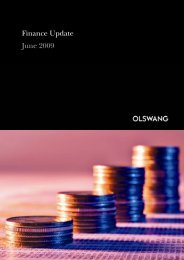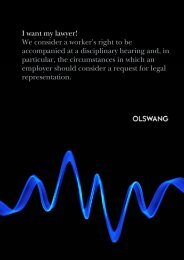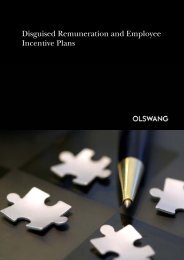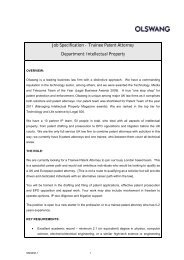Tax Advisor 2010 tax avoidance case law review - Olswang
Tax Advisor 2010 tax avoidance case law review - Olswang
Tax Advisor 2010 tax avoidance case law review - Olswang
Create successful ePaper yourself
Turn your PDF publications into a flip-book with our unique Google optimized e-Paper software.
earnings to employees in a <strong>tax</strong> efficient manner. It is surprising that the FTT decided that the<br />
Ramsay doctrine can apply in relation to the interpretation of highly prescribed technical code<br />
such as that contained in Part 7 ITEPA.<br />
Peter Schofield v Revenue and Customs Commissioners [<strong>2010</strong>] UKFTT 196 (TC)<br />
This decision concerned a complicated structure for the artificial creation of a capital loss<br />
involving four interlinked options. Viewing each option in isolation, a significant capital loss was<br />
made on the "closing out" of the first option, whilst a significant capital gain was made on the<br />
"closing out" of the third option. The <strong>tax</strong>payer argued that the capital loss on the first option was<br />
<strong>tax</strong> deductible whilst the capital gain on the third option was exempt from charge because it was<br />
an option over gilt-edged securities.<br />
The FTT had little difficulty in finding that the four options needed to be viewed as a single<br />
composite transaction under which no actual loss had arisen. The scheme had built in the<br />
possibility that, due to fluctuations in the FTSE 100, the scheme would only realise a small profit<br />
or a small loss, but this was not enough to stop Ramsay applying.<br />
This would appear to be a straightforward application of the House of Lords decision in Scottish<br />
Provident Institution v Revenue and Customs Commissioners [2005] STC 15; interlinked financial<br />
instruments should be viewed as a single transaction for the purposes of determining whether a<br />
loss has arisen, and the artificially inserted slim possibility of the scheme not working as planned<br />
can be ignored. Following the Court of Appeal’s restatement of this principle last year in Astall v<br />
Revenue and Customs Commissioners [<strong>2010</strong>] STC 137 this decision appeared inevitable.<br />
Andrew Berry v Revenue and Customs Commissioners [2009] UKFTT 386 (TC)<br />
This decision concerned gilt strip planning, which was a popular way of artificially creating an<br />
income loss through the acquisition of a gilt strip and the granting of an option over the gilt strip to<br />
a third party. The planning relied on creating a loss under paragraph 14A of Schedule 13 Finance<br />
Act 1996. To succeed the <strong>tax</strong>payer had to show that the scheme was not self-cancelling, in the<br />
sense that there was a realistic possibility that the option would not be exercised and Mr Berry<br />
would be left owning the gilt strips. To this end the scheme had built in to it a possibility (agreed<br />
by the parties as being 7%) that the option would not be exercised, such that Mr Berry was left<br />
owning the gilt strips.<br />
Unsurprisingly, the FTT applied Astall. The tribunal held that the possibility of the option not being<br />
exercised was part of the scheme, the parties proceeded on the basis that this possibility could<br />
be ignored, and so the possibility should be ignored in applying the legislation. In essence, this<br />
was a self-cancelling scheme in which Mr Berry never really owned the gilt strips and therefore<br />
3


